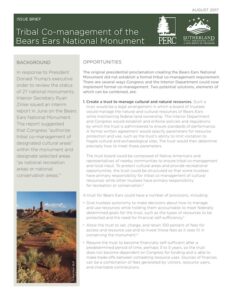 DOWNLOAD THE FULL REPORT
DOWNLOAD THE FULL REPORT
Background
In response to President Donald Trump’s executive order to review the status of 27 national monuments, Interior Secretary Ryan Zinke issued an interim report in June on the Bears Ears National Monument. The report suggested that Congress “authorize tribal co-management of designated cultural areas” within the monument and designate selected areas “as national recreation areas or national conservation areas.”1
Opportunities
The original presidential proclamation creating the Bears Ears National Monument did not establish a formal tribal co-management requirement. There are several ways Congress and the Interior Department could now implement formal co-management. Two potential solutions, elements of which can be combined, are:
1) Create a trust to manage cultural and natural resources.
Such a trust would be a legal arrangement in which a board of trustees would manage the natural and cultural resources of Bears Ears while maintaining federal land ownership. The Interior Department and Congress would establish and enforce policies and regulations by which the trust is administered to ensure standards of performance. A formal written agreement would specify parameters for resource protection and use, such as the trust’s ability to limit visitation to fragile cultural and archaeological sites. The trust would then determine precisely how to meet these parameters.
The trust board could be composed of Native Americans and representatives of nearby communities to ensure tribal co-management and local input. To protect cultural areas and provide recreational opportunities, the trust could be structured so that some trustees have primary responsibility for tribal co-management of cultural resources while other trustees have primary responsibility
for recreation or conservation.2
A trust for Bears Ears could have a number of provisions, including:
- Give trustees autonomy to make decisions about how to manage and use resources while holding them accountable to meet federally determined goals for the trust, such as the types of resources to be protected and the need for nancial self-sufficiency.3
- Allow the trust to set, charge, and retain 100 percent of fees for access and resource use and to invest those fees as it sees it in conserving the monument.4
- Require the trust to become nancially self-su cient after a predetermined period of time, perhaps 3 to 5 years, so the trust does not become dependent on Congress for funding and is able to make trade-offs between competing resource uses. Sources of finances can be a combination of fees generated by visitors, resource users, and charitable contributions.
2) Grant Native Americans legally binding or even exclusive rights to manage the region’s antiquities on federal land.
Currently, four national park units, including two national monuments, are jointly managed by the federal government and tribal partners and could serve as models.5 Substantive Native American co-management could include a number of provisions such as:
- Allow Native Americans to control access and retain 100 percent of income generated from visitors. This would ensure antiquities sites are not overrun by tourists and would also provide resources to help protect sites from vandalism, theft, and inadvertent damage.
- Create a formal management structure for Native Americans, such as a trust, so that they have a substantive management role rather than the current advisory role.6
- Formalize rights to historical Native American uses of the area, including grazing livestock, gathering rewood for heating homes, gathering food and hunting game, harvesting plants for medicinal and ceremonial purposes, and performing religious ceremonies.
- Establish a fair and transparent process to sort out competing Native American claims to co-manage antiquities sites on federal land.7
Download the full report, including endnotes and references.
 DOWNLOAD THE FULL REPORT
DOWNLOAD THE FULL REPORT

